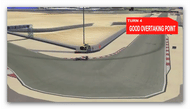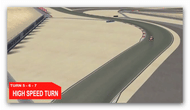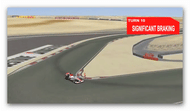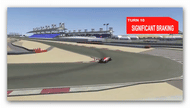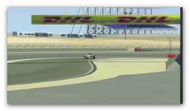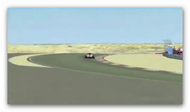The Bahrain Grand Prix is the next stop on the F1 calendar and as the F1 circus heads to the gulf state of Bahrain, let’s take a track guide of the Bahrain International circuit and take a look at some of the fast facts regarding the event.
Track Guide:
Sector 1:
The long 1090 metres pit straight marks the start of the Bahrain circuit lap. The DRS zone will be on this straight and most of the overtaking is likely to take place on this straight in the braking zone for turn 1.
Turn 1 is a slow speed tight right handed hairpin and the cars de-accelerate from more than 315 kph down to 65 kph in less than 3 seconds. The drivers have to cope upto 5G of braking force as they brake for turn 1 and the corner is particularly demanding on tyres.
Turn 1 is followed by fast and usually flat-out turns 2 and 3. Turn 2 and 3 are actually not corners but just a sort of kink and the exit out of turn 1 and through turns 2 and 3 is very important to get a good slipstream and overtake the car ahead in the braking zone for turn 4.
Turn 3 is followed by a short straight which leads to another slow speed right handed bend at turn 4. Turn 4 is also a very good overtaking spot and earlier when DRS wasn’t allowed, this was one of the main places to overtake. Last year also we saw number of overtakes being done at the entry of turn 4.
The exit of turn 4 leading to fast sequence of corners, turns 5, 6 and 7 mark the end of sector 1.
Sector 2:
The second sector begins with the fast and flowing turns 5, 6 and 7 through which the cars need to have good aerodynamic stability.
This then leads to a right handed hairpin at turn 8. The drivers brake from around 253 kph down to 79 kph and so the cars need to have good braking stability as it is very easy to lock up and lose a huge of chunk of time through turn 8. The exit of turn 8 leads to a short straight which then is followed up by very tough and tight sequence of right handed corners, turns 9 and 10.
The drivers approach turn 9 at speeds of around 205 kph and as they negotiate the right hand bend, they have to shift down 4 gears and reduce the speed to 63 kph. The off camber turns 9 and 10 put a lot of lateral load on the tyres and the drivers have to be precise with their bake application as it’s very easy to lock up going into turn 10 and run wide onto the run-off area.
Turns 9 and 10 is where bulk of time can be made or lost and is the most important corner of the Bahrain circuit. Getting a good exit out of turn 10 is also very important to make the most of the straight leading out from turn 10. Also, in the race, the straight from the exit of turn 10 can be used for overtaking opportunities.
The short straight from 10 then leads into medium speed left hander at turn 11. Turn 11 is a very tricky corner in terms of braking as you don’t want to brake too hard or too little, so the drivers have to be instinctive and judge the braking perfectly to make most out of the fast sequence of corners from turn 11 to 13.
Sector 3: (Starts from turn 13)
Following the exit of turn 11, the drivers are usually flat-out through turn 12 and then brake hard for the right handed hairpin at turn 13. Again, the braking for turn 13 needs to be picture perfect as it is very easy to lock up the fronts and lose a lot of time.
Turn 13 is followed up by a long straight which leads to the final corner of the circuit, turn 14 which in turn puts us back onto the pit straight and that’s the lap of the Bahrain International Circuit.
Image Courtsey: BoxGP
Event Guide:
History:
The Bahrain Grand Prix first made it to the F1 scene in the year 2004 and by doing so, it became the first country in the middle east to host a Formula 1 Grand Prix. The inaugural race was given the award for the “Best Organised Grand Prix” by the FIA.
The Bahrain grand Prix has usually been held as the third race of the season but in 2010 it swapped places with Australia and was the season opener. The 2011 Bahrain grand Prix was cancelled due to the 2011 Bahraini protests. The race was cancelled for 2011 after drivers including Damon Hill and Mark Webber protested.
Tyre and Strategy:
Pirelli have changed their tyre choices for the Bahrain Grand Prix and are bringing two of the hardest tyre compounds – the orange walled hard tyre and silver walled medium tyre. The Bahrain circuit has a very rough and harsh asphalt and as it is situated in the middle of a desert, lot of dust is also blown on track which makes life difficult for the drivers as the tyres’ performance and grip dips.
The harder tyre is expected to last 15-17 laps while the medium compound tyre is expected to last 12-14 laps. Strategy wise, Pirelli reckon that most of the teams will be doing 3 pit-stops.
Weather Forecast:
The weather is expected to be bright and warm with ambient temperatures expected to be around 34 degrees while asphalt temperature may rise up to 45 degrees.
Event Information:
RACENumber of Laps: 57Lap Distance: 5.412kmRace Distance: 308kmCircuit Direction: Clockwise
SCHEDULE: (Timing According to Indian Standard time: +5.30 GMT)
| Fri 19 April 2013 | |
|---|---|
| Practice 1 | 12:30 - 14:00 |
| Practice 2 | 16:30 - 18:00 |
| Sat 20 April 2013 | |
|---|---|
| Practice 3 | 13:30 - 14:30 |
| Qualifying | 16:30 |
| Sun 21 April 2013 | |
|---|---|
| Race | 17:30 |
CIRCUITTop Speed: 314kphAverage Speed: 214kphAverage Corner Speed: 138kphLongest Straight: 1205 meters
STRATEGYTypical Strategy: 3 stop raceSafety Cars: 14% chance
PITSTOPSFastest Pitstop (2012): 3.0 secondsNo. of Pitstops (2012): 71 stopsPit Loss: 21 secondsPitlane Length: 420 metres
AERODownforce Level: Medium (Low to Maximum)Cooling Requirement: High (Low to High)
ENGINEFuel Consumption: 2.5kg/lapFuel Laptime Penalty: 0.4s/10kgFull Throttle: 66% of lap

